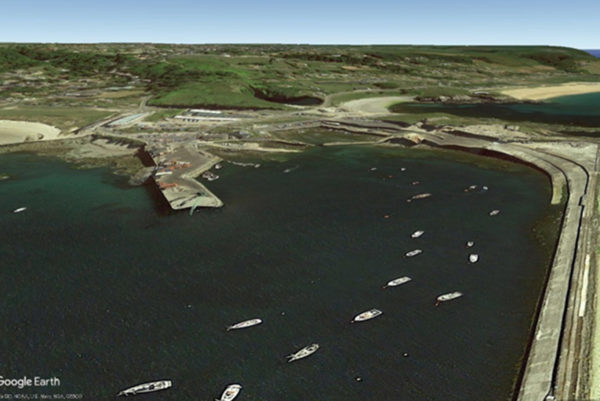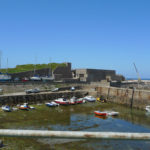Braye Harbour
- Country: Alderney, The Channel Islands
- GPS: 49° 43' 25.6188 N, -2° 12' 8.3412 W,
- Address: Braye, off Route de Crabby
- Operational: 02/07/1940 - 16/05/1945
By Caroline Sturdy Colls and Kevin Colls
From the arrival of the Germans through to the liberation and the return of the islanders, Braye Harbour stood as a witness to key events during the occupation. For soldiers, guards and labourers alike, this site was where they first experienced the place that they would spend significant periods of their life. For those who survived their ordeal, the harbour was also where they had their final experiences on the island before deportation.
From the start of the occupation, forced labourers undertook significant construction projects at the harbour.1 For many, this place offered both hope and despair in equal measure. For forced labourers governed by Organisation Todt, work here afforded the chance to steal vital supplies and/ or do lighter work, particularly if tasked with unloading the food and water sent to Alderney by boat.2 However, many workers also experienced harsh beatings and any thefts carried strict penalties, which included death.
After working at several other locations across the island, Victor Tiurin recalls that he only managed to escape the fate of many of his fellow labourers because he managed to secure work in the harbour where he could acquire some extra food. During his time on Alderney, he was aware of the proximity of the island to England and hoped that he and his fellow prisoners would get help from the British. In his post-war testimony, he described how efforts were made by labourers to alert the British to their presence. This included an ill-fated escape attempt by three of Tiurin’s friends who were hung when their stolen boat was detected by searchlights.3
The harbour was also where clear animosity and operational differences between the OT and SS administrations played out. After their arrival on 3 and 5 March 1943, a regular contingent of SS prisoners worked here, unloading ships, constructing tank barriers and carrying out expansion and repair works.4 Here, it was not so much the work that was harrowing, but rather the treatment they received. Several other German officers report that these workers were regularly beaten.5 They were forbidden to have contact with the OT labourers who also worked there, although in some cases they were able to share information regarding the atrocities in Sylt concentration camp.6 Witnesses recall that a guard named Sonn was particularly brutal in the way that he beat the prisoners, using a stick and aiming ‘mostly at their legs’.7 When questioned by his fellow guards, Sonn allegedly said it was none of their business.8 Other German soldiers witnessed how prisoners were beaten so badly while working in the harbour that they collapsed, covered in blood.9 Labourer John Dalmau also described shooting incidents that occurred there whenever the bombing of a German town took place.10
Other witnesses allude to the harbour also playing a role in the disposal of the dead. Ted Misiewicz recalled ‘one time this Russian boss said to me that if you want double portion of bread join our squad, I said what are you doing – he said we’re disposing bodies – putting them in marine type of a coffin, six at a time and taking them to the harbour and dropping them over the side you know that was the, that was the way they did it.11 Others, such as Georgi Kondakov, witnessed how a tip lorry was used to dump corpses off the breakwater in the harbour: ‘the lorry turned round, its back rose, and naked bodies starting falling into the sea.12 This is further corroborated in the words of Dalmau during his testimony.13
There have been numerous reports of encounters with human remains since the war including a newspaper report from 1992 also claims that, in the 1960s, bodies were reportedly found scattered over the seabed near Alderney, leading to the area being designated a war grave.14 However, given the strong tidal movements around Alderney, any human remains that were thrown into the sea would likely have been and swept away not long after being submerged and, as Sanders has correctly observed ‘some of these bodies may have been washed up elsewhere without this having necessarily come to the knowledge of the civilian population’.15 Unfortunately, investigating the accuracy of these claims, more than seventy-five years after they reportedly occurred, is almost impossible.16
References:
1 Bonnard, B. 2009 Alderney at War 1939-49. Stroud: The History Press, pp.138.
2 Georgi Kondakov in Bonnard, B. 1991 The Island of Dread in the Channel. Sutton Publishing Ltd. p. 49.
3 Summary of Tiurin’s testimony which featured in Territoriya avtomatizatsii, 3 May 2015, p. 17; Mr Tiurin, pers. comm.
4 ITS, 1.1.0.2./82342179–82342181, ‘Einsatz der SS-Baubrigaden’, 29 April 1944.; ITS, 1.1.0.2./82342175–82342176, ‘Einsatz der SS-Baubrigaden’, 14 February 1944.
5 IA, AQ875/03, ‘Statement of Otto Tauber’, 7 June 1945; TNA, WO311/12, ‘Statement of Werner Trautwetter’, 1945; TNA, WO311/12, ‘Statement of Horst Engel’, 21 May 1945; TNA, WO311/12, ‘Statement of Rudi Wolf’, 1945.
6 TNA, WO311/12, ‘Statement of Hans Schenk’, 21 May 1945; TNA, WO311/12, ‘Statement of Ferdinand Waas’, 25 May 1945.
7 TNA, WO311/12, ‘Statement of Werner Trautwetter’, 1945; TNA, WO311/11, ‘Statement of Lorenz Gmeinder’, 20th May 1945; TNA, WO311/12, ‘Statement of Rudi Wolf’, 1945.
8 TNA, WO311/12, ‘Statement Made by O/St. Gefr Friedrich Hausmann’, 1 July 1945.
9 TNA, WO311/12, ‘Statement of Josef Kaiser’, 1945.
10 J. Dalmau, Slave Worker in the Channel Islands (Guernsey: Guernsey Press Co Ltd, 1945), p. 19
11 IWM, MISC 2826 – 189/2, Nr.3376 ‘Interview with Ted Misiewiec’, undated.
12 Georgi Kondakov, in Bonnard, The Island of Dread, p. 52.
13 Dalmau, Slave Worker in the Channel Islands, pp. 18
14 Winder, pers. comm. and other sources who wish to remain anonymous. J. Dalrymple, ‘The haunted isles’, Sunday Times, 6 December 1992, 11.
15 Sanders, P. 2005 The British Channel Islands Under German Occupation 1940–45. Jersey Heritage Trust, p. 220.
16 Sturdy Colls and Colls, 2021 Adolf Island: The Archaeology of the Occupation of Alderney. Manchester University Press. Manchester.
Map
- Cemetery / Mass Grave
- Concentration Camp
- Forced Labour Camp
- Prison
- Worksite / Fortification



